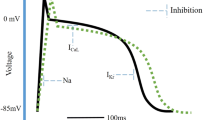Abstract
Using a previously developed population pharmacokinetic model, an exposure-response (ER) model was successfully developed to describe guanfacine plasma concentrations and changes in heart rate (HR) and the QT interval. Guanfacine exposure was associated with small decreases in HR and a small prolongation of the population-corrected QT (QTcP) interval. Based on the final ER model for effect of guanfacine on HR, the estimated population typical decrease in HR would be 2.3% (2.1–2.7%) of the baseline circadian HR for every 1 ng/mL of guanfacine exposure. A QTcP was developed for the analysis using the sampled population. An effect of sex on baseline-corrected QT (BQTP) was the only covariate effect in the final ER model for QTcP, its inclusion resulting in a typical baseline QTcP estimate that is 9 (5–13) ms higher for females. There was no evidence of QT-RR hysteresis. A linear model was used to relate guanfacine plasma concentrations to QTcP. The typical (95% confidence interval) slope parameter was estimated to be 0.941 (0.62–1.25) ms/ng/mL. The final model predicted an approximate 1-ms increase from baseline for every 1 ng/mL of guanfacine in plasma. The main predictor of QTcP prolongation was guanfacine exposure, which decreased with body weight and increased with dose.



Similar content being viewed by others
REFERENCES
National Institute of Mental Health. Attention deficit hyperactivity disorder (ADHD). US Department of Health and Human Services; 2008.
Biederman J, Faraone SV. Attention-deficit hyperactivity disorder. Lancet. 2005;366(9481):237–48.
Wolraich M, Brown L, Brown RT, et al. Implementing the key action statements: an algorithm and explanation for process of care for the evaluation, diagnosis, treatment, and monitoring of ADHD in children and adolescents. Pediatrics. 2011;128(5, supplemental information):SI1–21.
Wilens TE, Spencer TJ. The stimulants revisited. Child Adolesc Psychiatr Clin N Am. 2000;9(3):573–603. viii.
Cantwell DP. Attention deficit disorder: a review of the past 10 years. J Am Acad Child Adolesc Psychiatry. 1996;35(8):978–87.
Wilens TE, Spencer T, Biederman J, Wozniak J, Connor D. Combined pharmacotherapy: an emerging trend in pediatric psychopharmacology. J Am Acad Child Adolesc Psychiatry. 1995;34(1):110–2.
TENEX (guanfacine hydrochloride) tablet prescribing information. Bridgewater, NJ: Promius Pharma LLC; 2008.
TENEX: Summary of approval. A.H. Robbins Company. NDA No. 19-032. 1986. 1986.
INTUNIV® (guanfacine) extended-release tablets [package insert]. Wayne, PA: Shire Pharmaceuticals LLC.
Boellner SW, Pennick M, Fiske K, Lyne A, Shojaei A. Pharmacokinetics of a guanfacine extended-release formulation in children and adolescents with attention-deficit-hyperactivity disorder. Pharmacotherapy. 2007;27(9):1253–62.
Kollins SH, Lopez FA, Vince BD, et al. Psychomotor functioning and alertness with guanfacine extended release in subjects with attention-deficit/hyperactivity disorder. J Child Adolesc Psychopharmacol. 2011;21(2):111–20.
Beal SL, Sheiner LB, Boeckmann AJ. NONMEM users guide: part I-VII, (1989–2006). Ellicott City: Icon Development Solutions; 2006.
Piotrovsky V. Pharmacokinetic-pharmacodynamic modeling in the data analysis and interpretation of drug-induced QT/QTc prolongation. AAPS J. 2005;7(3):E609–24.
Parke J, Holford NH, Charles BG. A procedure for generating bootstrap samples for the validation of nonlinear mixed-effects population models. Comput Methods Programs Biomed. 1999;59(1):19–29.
Ette EI, Onyiah LC. Estimating inestimable standard errors in population pharmacokinetic studies: the bootstrap with Winsorization. Eur J Drug Metab Pharmacokinet. 2002;27(3):213–24.
Yano Y, Beal SL, Sheiner LB. Evaluating pharmacokinetic/pharmacodynamic models using the posterior predictive check. J Pharmacokinet Pharmacodyn. 2001;28(2):171–92.
National Center for Health Statistics. NHANES III, Third National Health and Nutrition Examination Survey, 1988–1994. Available at: http://www.cdc.gov/nchs/about/major/nhanes/nh3data.htm. Accessed 21 Feb 2013.
National Center for Health Statistics. CDC growth charts. Available at: http://www.cdc.gov/growthcharts/. Accessed 21 Feb 2013.
Wernicke JF, Faries D, Breitung R, Girod D. QT correction methods in children and adolescents. J Cardiovasc Electrophysiol. 2005;16(1):76–81.
ACKNOWLEDGMENTS
Funding for this research was provided by Shire Development LLC to Metrum. Melissa Brunckhorst, from MedErgy, provided editorial assistance in formatting, proofreading, and copy editing. This support was funded by Shire. Although the sponsor was involved in the design, collection, analysis, interpretation, and fact checking of information, the content of this manuscript, the ultimate interpretation, and the decision to submit it for publication in The AAPS Journal were made by all the authors independently.
Conflict of Interest
JE, PM, and JP are employees of Shire Development LLC and hold stock/stock options in Shire. WK and MRG are employees of Metrum Research Group LLC, which received funding from Shire Development LLC for this study.
Author information
Authors and Affiliations
Corresponding author
Electronic supplementary material
Below is the link to the electronic supplementary material.
Supplemental Fig. 1
Image shows a predictive check for median heart rates with distributions of simulated median heart rates (bpm) within each individual (C med) compared to the actual observed distribution of C med values from the population pharmacodynamic database and a predictive check for maximum population corrected QT (QTcP) intervals (ms) compared to the actual observed distribution of QTcP intervals from the population pharmacodynamic database. Quantile-quantile plots for each of the 100 simulation replicates are depicted by a gray dashed line and are overlaid on this plot. The black solid line represents a reference line of identity. Top image shows heart rate and bottom image shows QTcP intervals. (GIF 84 kb)
Supplemental Fig. 2
Image shows change in QTcP at steady-state C max versus weight for clinical trial simulations in pediatric ADHD patients receiving 2 or 4 mg of guanfacine. Simulated change in QTcP at steady-state C max is plotted against corresponding weight (kg). Values are plotted as open circles. Solid black line is reference for weight of 20 kg in 6-year old, dashed line is reference for weight of 50 kg in 12-year old, and dotted line is reference for weight of 65 kg in 17-year old. Left panel shows 2 mg dose and right panel shows 4 mg dose. (GIF 71 kb)
Rights and permissions
About this article
Cite this article
Knebel, W., Ermer, J., Purkayastha, J. et al. Population Pharmacokinetic/Pharmacodynamic Modeling of Guanfacine Effects on QTc and Heart Rate in Pediatric Patients. AAPS J 16, 1237–1246 (2014). https://doi.org/10.1208/s12248-014-9645-0
Received:
Accepted:
Published:
Issue Date:
DOI: https://doi.org/10.1208/s12248-014-9645-0




